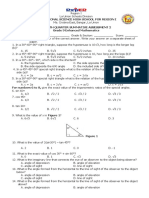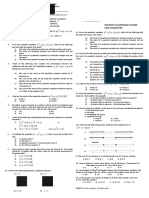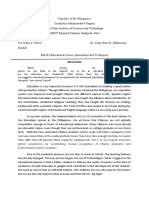G10 Fourth Periodical
G10 Fourth Periodical
Uploaded by
Leslie Vine DelosoCopyright:
Available Formats
G10 Fourth Periodical
G10 Fourth Periodical
Uploaded by
Leslie Vine DelosoOriginal Title
Copyright
Available Formats
Share this document
Did you find this document useful?
Is this content inappropriate?
Copyright:
Available Formats
G10 Fourth Periodical
G10 Fourth Periodical
Uploaded by
Leslie Vine DelosoCopyright:
Available Formats
HOLY CROSS OF MALITA, INC.
Manuel Peralta Street, Malita, Davao Occidental
4th Periodical Examination
Mathematics 10
Name: ________________________________________ Section: _______________
Teacher: Ms. Jennielou L. Ferriols Score: _______________
Test I. KNOWLEDGE
Multiple Choice. Read each statement carefully. Write the letter of the correct answer on the space provided
before the number.
_____ 1. These are values that divide a set of data into four equal parts.
a. Deciles b. Percentiles c. Quartiles d. Z-Scores
_____ 2. These are values that divide a set of data into one hundred equal parts.
a. Deciles b. Percentiles c. Quartiles d. Z-Scores
_____ 3. These are values that divide a set of data into ten equal parts.
a. Deciles b. Percentiles c. Quartiles d. Z-Scores
_____ 4. How many percentiles are there in the measures of position?
a. 90 b. 98 c. 99 d. 100
_____ 5. How many quartiles are there in the measures of position?
a. 10 b. 9 c. 4 d. 3
_____ 6. How many deciles are there in the measures of position?
a. 10 b. 9 c. 4 d. 3
_____ 7. What percent of data falls under 𝑃99 ?
a. 1% b. 90 % d. 99% d. 100%
_____ 8. Which of the following does not belong to the group?
a. Deciles b. Percentiles c. Quartiles d. Z-Scores
_____ 9. It is a branch of mathematics that concerns about data.
a. Algebra b. Calculus c. Geometry d. Statistics
_____ 10. It is the score which has 10% of the scores below it and 90% above it.
a. 𝐷1 b. 𝑃3 c. 𝑄1 d. 𝑍1
1 3
_____ 11. This value separates the bottom 4 of the sorted values from the upper 4 of the values.
a. 𝐷1 b. 𝑃3 c. 𝑄1 d. 𝑍1
_____ 12. These are information to be gathered, organized, presented and interpreted.
a. data b. datum c. table d. observation
_____ 13. It is obtained by subtracting the smallest quantity from the largest quantity.
a. mean b. media c. mode d. range
_____ 14.These are often described as the true limits.
a. Class boundaries b. Class Interval c. Class Limit d. Class Frequency
_____ 15. If the data are whole numbers, the lower boundary of a class is _____ less than its lower limit.
a. 0.0005 b. 0.005 c. 0.05 d. 0.5
_____ 16. If the data are rounded to the nearest hundredths, the lower boundary of a class is _____ less than its
lower limit.
a. 0.0005 b. 0.005 c. 0.05 d. 0.5
_____ 17. In computing the quartiles of a grouped data, it denotes the sum of frequencies.
a. 𝑙𝑏𝑞𝑐 b. ∑ 𝑓 c. 𝑐𝑓 d. 𝑓𝑞𝑐
_____ 18. In computing the quartiles of a grouped data, it denotes the frequency of the quartile class.
a. 𝑙𝑏𝑞𝑐 b. ∑ 𝑓 c. 𝑐𝑓 d. 𝑓𝑞𝑐
_____ 19. In computing the quartiles of a grouped data, it denotes the cumulative frequency of the lower class
next to the quartile class.
a. 𝑙𝑏𝑞𝑐 b. ∑ 𝑓 c. 𝑐𝑓 d. 𝑓𝑞𝑐
_____ 20. In computing the quartiles of a grouped data, it denotes the lower boundary of the quartile class.
a. 𝑙𝑏𝑞𝑐 b. ∑ 𝑓 c. 𝑐𝑓 d. 𝑓𝑞𝑐
TEST II. PROCESS
Problem Solving. Read and solve the following. Use a clean sheet of paper for numbers 1 and 3.
Rubric
5 points – correct 𝑄𝑚 with correct step by step solution
3 points – correct 𝑄𝑚 with incomplete solution
1 point – correct 𝑄𝑚 without solution
1. These are the scores of 11 students in a test: 30, 12, 10, 16, 18, 24, 29, 27, 22, 14, and 15.
Solve for 𝑄1 , 𝑄2 , and 𝑄3 given the data below.
2. Solve for 𝑄1 of grouped data.
The following are heights in centimeters of 35 students.
124 126 134 138 142 143 136
131 138 135 128 131 146 136
133 120 136 126 137 139 137
141 131 127 130 132 138 142
140 136 132 133 138 140 144
Step 1. Find the range. (2 points) Step 2. Determine k, the approximate Step 3. Determine the interval i.
𝑅𝑎𝑛𝑔𝑒 = 𝐿𝑎𝑟𝑔𝑒𝑠𝑡 𝑉𝑎𝑙𝑢𝑒 − 𝑆𝑚𝑎𝑙𝑙𝑒𝑠𝑡 𝑉𝑎𝑙𝑢𝑒 number of classes. (2 points) (2 points)
𝑘 = 1 + 3.322 log 𝑁 𝑅𝑎𝑛𝑔𝑒
𝑖=
𝑘
Step 4. Construct a frequency distribution table. (7 points)
N = ______
Less than
Class
Class Intervals Tally Frequency Cumulative
Boundaries
Frequency
∑ 𝑓 = _________
Step 5. Finally, solve for 𝑄1. (7 points)
𝑟∑𝑓
− 𝑐𝑓
𝑄𝑟 = 𝑙𝑏𝑞𝑐 + [ 4 ]𝑖
𝑓𝑞𝑐
3. Find 𝐷2 for the given set of scores of seven grade ten students in a test.
(2 points – correct decile; 2 points – correct solution; 1 point - correct interpretation)
81, 72, 94, 66, 85, 70, 87
TEST III. UNDERSTANDING
Read and answer the following.
Rubrics:
10 pts. – The answer is clearly stated, organized and well-presented with justification.
8 pts. – The answer is presented with justification.
6 pts. – The answer is presented but lacks justification.
4 pts. – The answer lacks organization and lacks justification.
1. If your score is in 5th decile, would you be satisfied or not? Why? Justify your answer.
“Dare to dream big.”
May God bless you always.
You might also like
- 2019FS026 Communicate With FusionSolar Through An openAPI AccountDocument13 pages2019FS026 Communicate With FusionSolar Through An openAPI Accountwbwfalwcbggsr logicstreakNo ratings yet
- FS Episode 8Document18 pagesFS Episode 8Abegail Linaga93% (104)
- Messerschmitt BF 109 FIGHTER 1935Document114 pagesMesserschmitt BF 109 FIGHTER 1935Mihai Iavorschi100% (3)
- Illustrated Notes-Form One and Two NotesDocument131 pagesIllustrated Notes-Form One and Two NotesDi'genius Neshmentation100% (3)
- Chart Patterns ForexDocument16 pagesChart Patterns Forexnishitsardhara83% (6)
- Stats ExamDocument3 pagesStats Examjeffrey almozaraNo ratings yet
- 4th Final ExamDocument3 pages4th Final ExamMark Kiven MartinezNo ratings yet
- Fourth Periodical Test in Mathematics 10 - NKDocument5 pagesFourth Periodical Test in Mathematics 10 - NKEarl BuzzerNo ratings yet
- LONG-QUIZ-MATH-8 4TH QuarterDocument8 pagesLONG-QUIZ-MATH-8 4TH QuarterMICHAELA AQUINONo ratings yet
- Department of Education Schools Division of Nueva Ecija Fourth Periodical Examination Mathematics 7Document5 pagesDepartment of Education Schools Division of Nueva Ecija Fourth Periodical Examination Mathematics 7Myra Ramirez Ramos0% (1)
- E Math 9 4TH Quarter Sum T 2 2021 2022Document2 pagesE Math 9 4TH Quarter Sum T 2 2021 2022Sophia MillaresNo ratings yet
- Jose Sanvictores Sr. National School: Lesson Plan in Math Grade 9 I. ObjectivesDocument3 pagesJose Sanvictores Sr. National School: Lesson Plan in Math Grade 9 I. ObjectivesAngela RuleteNo ratings yet
- Math 4th GradingDocument2 pagesMath 4th GradingDawn Razonable100% (1)
- Saint James Academy, Inc.: Test I. Multiple ChoiceDocument2 pagesSaint James Academy, Inc.: Test I. Multiple ChoiceMeace Javier Gallinero DrilonNo ratings yet
- 4th Quarter Test in G9 22Document2 pages4th Quarter Test in G9 22Ma Fretchie Cabale MendovaNo ratings yet
- MATH 9 SUMMATIVE Test Q2 SET-A 2021Document3 pagesMATH 9 SUMMATIVE Test Q2 SET-A 2021Mhar Gallien Serrano100% (1)
- Summative Test in Mathematics 8 Quarter 3: PITOGO COMMUNITY HIGH SCHOOL (Grades 7 To 12) - 301376Document2 pagesSummative Test in Mathematics 8 Quarter 3: PITOGO COMMUNITY HIGH SCHOOL (Grades 7 To 12) - 301376EMERALD URLANDANo ratings yet
- 4th PT in Math 9-2022-2023Document5 pages4th PT in Math 9-2022-2023Pagalanggang NHS (R III - Bataan)No ratings yet
- Math 9Document4 pagesMath 9Hansel VillasorNo ratings yet
- Summative Test FourthDocument3 pagesSummative Test FourthCatherine FadriquelanNo ratings yet
- Exam g8Document5 pagesExam g8Sarah Jane Nomo100% (1)
- I. Write True If The Statement Is Correct or False If It Is Incorrect. (15 PTS.)Document3 pagesI. Write True If The Statement Is Correct or False If It Is Incorrect. (15 PTS.)John Francis VallejosNo ratings yet
- Mathematics - Grade 7 I. Multiple Choice: Write The Letter of Your AnswerDocument2 pagesMathematics - Grade 7 I. Multiple Choice: Write The Letter of Your AnswerEdelyn Paulinio100% (2)
- Quarter 2 Post-TestDocument4 pagesQuarter 2 Post-TestRoberto Del CarmenNo ratings yet
- Summative Test in Mathematics 8 Quarter 4Document2 pagesSummative Test in Mathematics 8 Quarter 4Irish Rhea FamodulanNo ratings yet
- Smmative Math 9Document4 pagesSmmative Math 9Genevieve Buniel EstalNo ratings yet
- G9 Pretest For Division Office 19Document3 pagesG9 Pretest For Division Office 19ANGELIE ITACNo ratings yet
- Comillas High School: I. Direction: Read Each Item Carefully. Choose The Letter of The Correct AnswerDocument2 pagesComillas High School: I. Direction: Read Each Item Carefully. Choose The Letter of The Correct AnswerMichelle O. MatiasNo ratings yet
- Long Quiz 2 4th g10 MathDocument2 pagesLong Quiz 2 4th g10 MathDollie May Maestre-Tejidor0% (1)
- 4th QTR MathDocument3 pages4th QTR MathLador GiovanniNo ratings yet
- Math 7 - Summative Week 678Document2 pagesMath 7 - Summative Week 678Brian MaryNo ratings yet
- UPDATED and FINAL CO1 2023-2024Document6 pagesUPDATED and FINAL CO1 2023-2024Ayeshah Rtb NiqabiNo ratings yet
- Math 9 First PTDocument4 pagesMath 9 First PTNimfa PlazaNo ratings yet
- 1st Departmental TestDocument3 pages1st Departmental TestJean Marie Ga LacsonNo ratings yet
- Quarter 2 ExamDocument5 pagesQuarter 2 ExamnoemiNo ratings yet
- First Periodical ExamDocument4 pagesFirst Periodical ExamJave Gene De AquinoNo ratings yet
- 1-4. Use The Table at The Right For Questions 1, 2, 3 and 4Document2 pages1-4. Use The Table at The Right For Questions 1, 2, 3 and 4Arsenio Cole Jr100% (1)
- Summative Test Quarter 1Document2 pagesSummative Test Quarter 1ma jessa cayago100% (1)
- Long Quiz - Math 9 Q3Document4 pagesLong Quiz - Math 9 Q3Nicole Asilum100% (1)
- Q2 LAS Math8 Wk1Document7 pagesQ2 LAS Math8 Wk1MIRAFLOR CUARTERONo ratings yet
- Second Periodical Test in Math 10 222 23Document4 pagesSecond Periodical Test in Math 10 222 23Cei-CeiNo ratings yet
- Math 9 ExamDocument6 pagesMath 9 ExamWerty Gigz DurendezNo ratings yet
- Q3 2ND Summative Test in Math 10Document1 pageQ3 2ND Summative Test in Math 10milafer dabanNo ratings yet
- 4th Periodical Exam - Math 9Document3 pages4th Periodical Exam - Math 9jenelynNo ratings yet
- Math 9 DLL Q2 W1 D5Document3 pagesMath 9 DLL Q2 W1 D5Joy GeronimoNo ratings yet
- Summative Test in Math 7Document4 pagesSummative Test in Math 7gaymarie.ecat100% (1)
- First Periodical Test - Math 10Document2 pagesFirst Periodical Test - Math 10Ai RenNo ratings yet
- 2nd QuarterDocument4 pages2nd QuarterCarlo Delos SantosNo ratings yet
- Math10-2nd QTRDocument7 pagesMath10-2nd QTRWyzty DelleNo ratings yet
- CH 16 PowerpointDocument42 pagesCH 16 PowerpointtoinksNo ratings yet
- Math 8 4th Grading ExamDocument2 pagesMath 8 4th Grading ExamGina QuirosNo ratings yet
- Math 8 Third 2020Document3 pagesMath 8 Third 2020Florita LagramaNo ratings yet
- Life Is The Most Difficult Exam. Many People Fail Because They Try To Copy Others, Not Realizing That Everyone Has A Different Question Paper.Document3 pagesLife Is The Most Difficult Exam. Many People Fail Because They Try To Copy Others, Not Realizing That Everyone Has A Different Question Paper.Agyao Yam FaithNo ratings yet
- Grade 8 and 9 Questionnaires - QuizBeeDocument8 pagesGrade 8 and 9 Questionnaires - QuizBeeHeidee BasasNo ratings yet
- Math 9 - Quarter 3 - Week 7 - Summative TEstDocument2 pagesMath 9 - Quarter 3 - Week 7 - Summative TEstPia CabaloNo ratings yet
- Tos First Quarter Exam 19 20Document4 pagesTos First Quarter Exam 19 20Royce Dunhill Fortes DomondonNo ratings yet
- Department of Education Buenavista National High SchoolDocument4 pagesDepartment of Education Buenavista National High Schoolchristine may feliaNo ratings yet
- Third Quarter Examination Grade 9 - Mathematics NAME: - DATE: - SCORE: - General RulesDocument3 pagesThird Quarter Examination Grade 9 - Mathematics NAME: - DATE: - SCORE: - General RulesJeo HuminisNo ratings yet
- Math 10Document4 pagesMath 10Werty Gigz DurendezNo ratings yet
- Test Question: Schools Division of San Carlos City Cluster of Non-Implementing UnitsDocument2 pagesTest Question: Schools Division of San Carlos City Cluster of Non-Implementing UnitsYeoj Paras100% (1)
- Math 8 Week 3 Quarter 4Document10 pagesMath 8 Week 3 Quarter 4Juliana ChuaNo ratings yet
- 1 Properties of Equality PPT nj4c00Document23 pages1 Properties of Equality PPT nj4c00junior highNo ratings yet
- 1.summative-Test Math7Document1 page1.summative-Test Math7Jaylor GaridoNo ratings yet
- Republic of The Philippines Department of EducationDocument3 pagesRepublic of The Philippines Department of EducationMarvelous VillafaniaNo ratings yet
- Math 10 4TH Periodical TestDocument2 pagesMath 10 4TH Periodical TestJeorge HugnoNo ratings yet
- Depersonalization ReportDocument4 pagesDepersonalization ReportLeslie Vine DelosoNo ratings yet
- Set TheoryDocument58 pagesSet TheoryLeslie Vine DelosoNo ratings yet
- DLL Sample (Blank Sheet)Document2 pagesDLL Sample (Blank Sheet)Leslie Vine DelosoNo ratings yet
- 2nd QUARTERLY EXAM MATH 9Document1 page2nd QUARTERLY EXAM MATH 9Leslie Vine DelosoNo ratings yet
- Acsenergylett 1c02591Document23 pagesAcsenergylett 1c02591Syeda Ammara AnwarNo ratings yet
- Jazz Improvisation - Essential Exercises, Technique, and Tips - MATT WARNOCK GUITARDocument42 pagesJazz Improvisation - Essential Exercises, Technique, and Tips - MATT WARNOCK GUITARleofds100% (1)
- Earth and Life Science Mod 10Document13 pagesEarth and Life Science Mod 10Jonna RizaNo ratings yet
- GP SheetDocument14 pagesGP SheetAyan RazaNo ratings yet
- Iapmo 4197 PDFDocument15 pagesIapmo 4197 PDFIvan FlorezNo ratings yet
- Noli Me TangereDocument4 pagesNoli Me TangereGrace Cañones-TandasNo ratings yet
- SUMMATIVE TEST For Month of DecemberDocument3 pagesSUMMATIVE TEST For Month of DecemberMaricar AustriaNo ratings yet
- Activity #1 ReflectionDocument1 pageActivity #1 ReflectionIvy Claire Segundo TorresNo ratings yet
- Nicholas Tse - Huang Zhong Ren (Yellow Race) LyricsDocument3 pagesNicholas Tse - Huang Zhong Ren (Yellow Race) LyricsCleopatra Antonio100% (1)
- NurmalaDocument8 pagesNurmalaIda YuniartiNo ratings yet
- Alstrom Series ASTEG Steam Generator BrochureDocument2 pagesAlstrom Series ASTEG Steam Generator BrochureAnonymous 7xHNgoKE6eNo ratings yet
- Midterm Reviewer CwtsDocument7 pagesMidterm Reviewer CwtsNayeonie imNo ratings yet
- A Snapshot On Rooppur Nuclear Power Plant ProjectDocument10 pagesA Snapshot On Rooppur Nuclear Power Plant ProjectSabiha Mahafuza ZozoneeNo ratings yet
- TM-500 - 600 Manual-2009-2Document33 pagesTM-500 - 600 Manual-2009-2Kay YusuffNo ratings yet
- B4 109 2014Document10 pagesB4 109 2014Yogesh OjhaNo ratings yet
- ON Sci 9 Unit1 Sec12Document7 pagesON Sci 9 Unit1 Sec12Girlie Kaye PagtamaNo ratings yet
- Introduction To: PhytochemistryDocument39 pagesIntroduction To: PhytochemistryBem LimNo ratings yet
- Bai Bao CaoDocument54 pagesBai Bao Caolaikhanhly13042002No ratings yet
- LogDocument27 pagesLogchaaanrikkaNo ratings yet
- At International LawDocument154 pagesAt International Lawjmanu9997No ratings yet
- Jonah LissnerDocument5 pagesJonah Lissnerjoscho2808No ratings yet
- Carbonx Ultimate Dj77-LoresDocument2 pagesCarbonx Ultimate Dj77-Loresme100% (1)
- Kahn 1986Document28 pagesKahn 1986an100% (1)
- AN ANALYSIS OF DEIXIS USED YULE by Tiur 17810008 & Hasyanty TurnipDocument9 pagesAN ANALYSIS OF DEIXIS USED YULE by Tiur 17810008 & Hasyanty Turnipimelda huraNo ratings yet
- The Business As Usual Behind The Slaughter - Lars SchallDocument17 pagesThe Business As Usual Behind The Slaughter - Lars SchallAlonso Muñoz PérezNo ratings yet





























































































